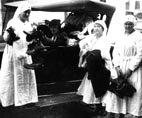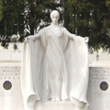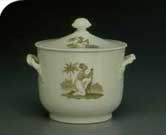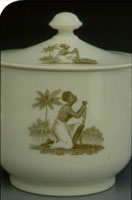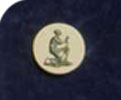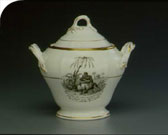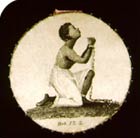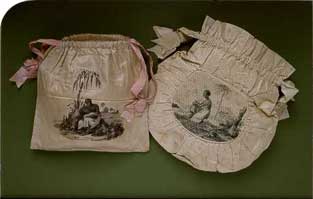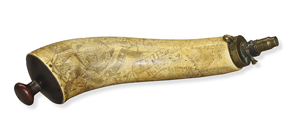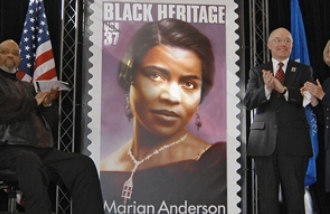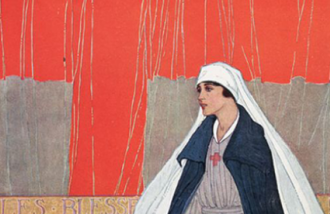Artifacts of the Abolitionist Movement at the DAR Museum |
The DAR Museum is fortunate to own several objects from the American anti-slavery movement of the early 19th century. Images, slogans and poems designed to win sympathy for slaves and support for the abolitionist cause were printed on everything from paper broadsides to pin-holders, from purses to china. The majority of these items were made in the 1830s and 1840s.
While some social critics had long been vocal in their criticism of slavery, the abolitionist movement gained new momentum in the 1830s with the founding of the American Anti-Slavery Society in Philadelphia in 1833, and similar organizations in other cities, notably New York City; Boston and Rochester, New York (where Frederick Douglass lived beginning in the 1840s). The goals of these organizations varied: some were eager to end slavery without addressing the larger issues of racial equality, some supported emigration of freed slaves back to Africa, while others vehemently opposed this.
Women critical to the anti-slavery movement
|
Women were very involved in anti-slavery societies and all aspects of the movement. Frederick Douglass himself wrote that "when the true history of the anti-slavery cause shall be written, women will occupy a large space in its pages; for the cause of the slave has been peculiarly woman's cause. Her heart and her conscience have supplied in large degree its motive and mainspring." |
Women challenged their assigned social role to take a stand
|
The 19th century view of women's nature and role in society gave conflicting messages to women who interested themselves in the movement. Women were said to have more moral and sympathetic impulses, which made them "naturally" inclined to sympathize with the plight of the slave; on the other hand, society saw women's sphere as purely domestic. Taking an interest-or worse, becoming actively involved-in politics and public policy, was considered immodest, unfeminine, and inappropriate. However, many "female societies" in support of the abolitionist cause were formed, a sort of compromise. Some were more conservative, even more concerned with slavery as a moral stain on whites' consciences than with racial issues; others included women willing to be criticized for making speeches, and who took more radical stands for racial equality, looking beyond emancipation to establishing legal and civil rights for African-Americans. |
Abolitionism as a springboard for feminism
|
To a large extent, the feminist movement grew out of the anti-slavery societies. Pondering the lack of rights for slaves led some members to compare the lack of legal rights for women. Other women found themselves thrust into the women's rights movement as a direct result of the discrimination they encountered within abolitionist circles.
|
Anti-Slavery Fundraisers
|
Anti-slavery societies often held fundraising events such as bazaars, at which items with abolitionist imagery (such as the kneeling slave) were sold. Serving sugar from a sugar bowl or carrying a purse with such an image, as well as an emotionally affecting poem, was the period equivalent of a T-shirt or bumper sticker announcing one's political beliefs or support of a certain cause today. Sugar plantations, of course, usually depended on slave labor; many abolitionists made a point of boycotting goods based on slave labor, or found sources for cotton, sugar, and other items that did not rely on slavery. |
Persuasive Images
|
Sarah Grimke, one of the most prominent and radical anti-slavery writers, called these images "powerful auxiliaries in the cause of emancipation, and [we] recommend that these 'pictorial representations' be multiplied…so that the speechless agony of the fettered slave may unceasingly appeal to the heart of the patriotic, the philantropic, and the christian." (quoted in Phillip Laspsansky, "Graphic Discord: Abolitionist and Antiabolitionist Images," in The Abolitionist Sisterhood: Women's Political Culture in Antebellum America, Jean Fagan Yellin and John C. Van Horne, eds.) |
To Modern Eyes
|
To modern eyes, the images of half-naked figures in subservient postures seem patronizing, even demeaning. At the time, however, these images, and the sentimental poetry accompanying them, were intended to rouse sympathy. The strategy of many of these appeals was to gain public sympathy for the people treated so cruelly by slavery. More radical and strident rhetoric, especially from female organizations whose very existence was already considered by many to be inappropriate, would not have gained either followers or support.
"I am persuaded [the kneeling slave cameo] may have an Effect equal to that of the best written Pamphlet in procuring favour to those oppressed People," Benjamin Franklin wrote. He had received a gift of several medallions from their manufacturer, the potter, businessman, and anti-slavery activist Josiah Wedgwood. Wedgwood, a member of the English "Committee for the Abolition of the Slave Trade," commissioned his modeler (designer) William Hackwood to create a cameo based on the seal of the Committee depicting a kneeling slave in chains under the words "AM I NOT A MAN AND A BROTHER?" It was produced mostly in black and white jasper (as in the example seen here) and was given as a gift to all those committed to the cause of abolition. These medallions were often mounted in settings and worn as combs, tie pins, bracelets, and other items of dress; they became a fashionable means of disseminating the abolitionist cause. In 1788, Wedgwood sent a number of cameos to Benjamin Franklin, who was the president of the Pennsylvania Society for the Abolition of Slavery. This medallion has since become an international symbol for oppression and was continually reproduced by Wedgwood throughout the 19th and 20th centuries. Friends of the Museum purchase 82.53
In 1828 British abolitionists created a companion figure to the already-famous "Am I not a Man" figure: a female kneeling with the caption "Am I not a Woman and a Sister?" possibly in response to the growing awareness of women's contributions to the abolitionist cause. Neither the bowl nor the pin holder uses the inscription; the slogan was probably so well known that the image alone was considered sufficient. The pin holder has "Heb. 13.3" under the figure, referring to the Bible verse which says, "Remember them that are in bonds, as bound with them; and them which suffer adversity, as being yourselves also in the body." On the reverse side is printed an excerpt of a newspaper announcement for the sale of a 5-year-old girl. |
Elizabeth Margaret Chandler, Abolitionist Writer and Editor
|
The DAR Museum's abolitionist purses, leather coin purse, and pin holder were owned by Elizabeth Margaret Chandler, or by members of her family. Chandler was a Quaker in Philadelphia, and a member of a reasonably well-to-do family. Although uninterested in speaking in public, as some of the more radical abolitionists chose to do, Chandler's poems and other anti-slavery writings, and her position as editor of the ladies' section in one of the abolitionist journals, made her an influential member of the movement. It was Chandler, as editor of the "Ladies' Repository" section of The Genius of Universal Emancipation, who introduced one of the most famous abolitionist images to the United States, that of the kneeling female slave, in 1830. Two years later, William Lloyd Garrison, a leader in the anti-slavery movement and editor of The Liberator, one of the most prominent abolitionist papers, adopted the symbol and slogan to head its "Ladies Department." Sojourner Truth's famous "Ain't I a Woman?" speech of 1852 echoes this famous slogan.
Elizabeth Margaret Chandler is believed to have owned these purses; possibly one or more belonged to another member of her family. Each features a dramatic picture of a slave on one side and a poem or inscription on the back. The square purse's image is the same as on one of the sugar bowls (above); both the bowl and the purse print the same inscription: "Negro Woman who sittest pining in captivity and weepest over thy sick child; though no one seeth thee, God seeth thee; though no one pitieth thee, God pitieth thee; raise thy voice, forlorn and abandoned one; call upon him from amidst thy bonds for assuredly He will hear thee." According to Elizabeth Cady Stanton, the organized movement for women's suffrage began at the World's Anti-Slavery Convention of 1840, in London. When women were not allowed to be seated at this convention, Stanton and Lucretia Coffin Mott made plans for a woman's rights convention to be held in America. Eight years later they issued the call for what became known as the Seneca Falls Convention of 1848-the first women's rights convention in America. (Quoted in, Tuggle, Catherine and Dunkley, Diane, Talking Radicalism in a Greenhouse, DAR Museum exhibition checklist, 1995-96.) |


